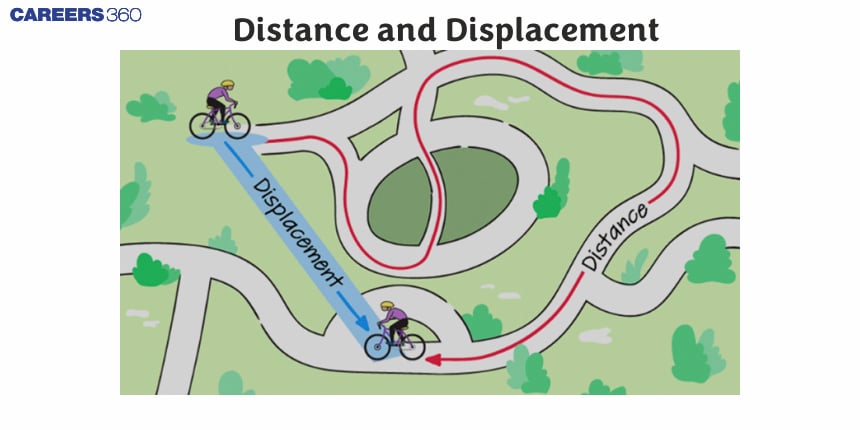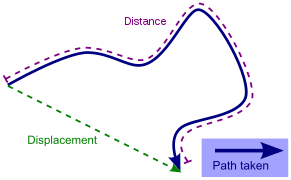Distance and Displacement - Definition, Examples, Difference, FAQs
In the study of motion, distance and displacement are fundamental concepts that describe how far an object moves, yet they differ significantly in their approach. Distance refers to the total length of the path an object travels, regardless of its direction while Displacement refers to the change in position of an object from its initial point to its final point in a specific direction. Let us understand the definition of Distance and Displacement, related formulas, unit and their differences.
JEE Main/NEET 2027: Physics Important Formulas for Class 10
NEET 2025: Mock Test Series | Syllabus | High Scoring Topics | PYQs
JEE Main: Study Materials | High Scoring Topics | Preparation Guide
JEE Main: Syllabus | Sample Papers | Mock Tests | PYQs
- What is Distance?
- What is Displacement?
- Similarities of Distance and Displacement Difference
- What is the Difference Between Distance and Displacement?

What is Distance?
Distance is a scalar number, which indicates that the distance between two objects is independent of their motion direction. The distance can never be 0 or negative, and it must always be greater than the object's displacement. The object's distance provides detailed information about the path it has taken.

For example, If an object is moving from point O to Q then the path length will be equal to distance $OQ=240 \mathrm{~m}$.

The distance is a scalar quantity. It has only magnitude and no direction.
Also, check-
- NCERT Solutions for All Subjects
- NCERT Exemplar Solutions for All Subjects
- NCERT Notes for all subject
What is Displacement?
Displacement d, also called length or distance, is a one-dimensional quantity representing the separation between two defined points.
For example, if A particle is moving from point P to O then the displacement of the particle is given by:
Displacement $(S)=$ position of point $O-$ Position of point $P=0-360=-360 \mathrm{~m}$
The negative sign shows the direction of the displacement.

Similarities of Distance and Displacement Difference
There are some parallels between distance and displacement difference that you should be aware of-
The difference in distance and displacement units is the same in S.I. units, namely meters (m).
Both measurements necessitate the use of a reference point.
If the motion of the object is in a straight line and in a single direction, they are equal.
Both distance and displacement have the same dimensions.
| Related Topics |
What is the Difference Between Distance and Displacement?
Here is the difference between Distance and Displacement. These are scalar and vector quantities respectively
| Sl. No. | Different properties | Distance | Displacement |
| 1. | Definition | The distance between any two points is the total length of the path. | The direct length between any two points measured along the shortest path between them is called displacement. |
| 2. | Denotation | d | s |
| 3. | Direction Consideration | The direction is ignored when calculating distance. | The direction is taken into account when calculating displacement. |
| 4. | Quantity | The magnitude, not the direction, determines the value of a scalar quantity. | Because it depends on both magnitude and direction, displacement is a vector quantity. |
| 5. | Route Information | The term "distance" refers to the specific route information used when travelling from one location to another. | Because displacement only refers to the quickest way, it does not provide entire route information. |
| 6. | Formula | speed × time | velocity × time |
| 7. | Possible values | Only positive numbers can be used in the distance. | Positive, negative, or even zero displacement is possible. |
| 8. | Measurement in non-straight path | A non-straight path can be used to calculate the distance. | Only a straight road may be used to quantify displacement. |
| 9. | Indication | An arrow does not represent distance. | An arrow is always used to denote displacement. |
| 10. | Path dependence | The distance is determined by the path followed, and it varies depending on the way taken. | Displacement is independent of the path and solely depends on the body's initial and ending positions. |
These are the key distinctions between distance and displacement difference that can aid in making a clear distinction between the two. These differences in distance and displacement, presented in tabular form, can help students remember the ideas more easily.
Frequently Asked Questions (FAQs)
The term "distance" refers to "how much ground an object has covered" during its travel.
The units of displacement and distance which are both same that is meters in standard unit. They both requires reference point in order to measure from initial point.
The metre is the SI unit of measurement for distance.
The metre is the SI unit of displacement.
CGS units of measurement are centimetres.
Also Read
05 Feb'25 04:57 PM
11 Jan'25 03:00 PM
24 Dec'24 01:28 PM
27 Nov'24 01:02 PM
26 Nov'24 01:31 PM
20 Nov'24 04:50 PM
20 Nov'24 12:59 PM
16 Nov'24 01:06 PM
14 Nov'24 04:17 PM
13 Nov'24 11:06 AM